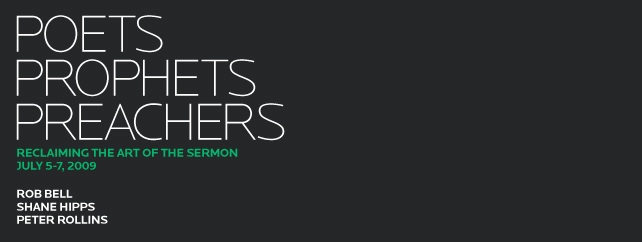poets, prophets and preachers: the beginning is the end is the beginning

well, day 2. poets, prophets and preachers. rob bell. peter rollins. shane hipps.
wow.
for a quick background of where i am and what i’m doing, you might want to return to yesterday’s blog post.
it’s been in many ways an overwhelming brain pummeling of just mounds of incredible and transformative information. in other ways, though, it’s been such a refreshing swim in the waters of escape and re-energizing and refocusing. it’s been an opportunity to hear voices of rethinkers and reclaimers. it’s been both mind-blowing and mind-fixing.
typically when i blog, it’s a very free-flowing easy thing. i sit. i write. i’m done. in this case, though, i’ve literally had my editor pulled up for more than an hour, pondering what the best angle was to communicate the experience thus far. i want to tell it all, but i also sense that telling it all would be novel-like instead of blog-like.
so, instead, i’ll try to distill things down to a manageable read by simply focusing on the biggest highlight and “aha” moment of the day.
the “aha” moment today—the mind blowing, transformative, generative moment—came during rob bell’s first talk, the story we’re telling. the fundamental premise was that in order to communicate the story of god effectively, we need to get to the story under the story under the story. we need to get to the true essence of the christian narrative. the explicit hypothesis was
where and how you begin the story and where and how you end the story determines the story you’re telling.
in other words, the order of how we tell the story inherently determines the nature of the content of and subsequent response to the story. so, naturally, one should start at the beginning and end at the end. what’s the beginning? creation. genesis. what’s the end? the apocalyptic revelation of john. omega.
what happens in the beginning? god creates and he calls it good. not only did he call it good, but he blessed it. what we find is a god who creates things that create. god creates trees that are able to recreate themselves. god creates people who are able to recreate themselves. god’s creation, then, become co-creators with god. there is an active participatory physicality to life on earth. god’s actions occur here. on earth. not “somewhere else”. it’s here. there isn’t a separation of spiritual and physical. soil and spirit are one. all things are created “good” and god blessed all things. there’s a created order. god > humans > earth. when things are rearranged, it is disruptive to the order that god created. nevertheless, there is a symbiotic relationship with god and god’s creation.
so, what happens in the end? in revelation 21, we find this:
And I heard a loud voice from the throne saying, “Now the dwelling of God is with men, and he will live with them. They will be his people, and God himself will be with them and be their God. …for the old order of things has passed away.” He who was seated on the throne said, “I am making everything new!”
what happens in the end? the action returns to earth. the ending of the story is here—not “somewhere else”. where does god dwell in the end? here. on earth. the story of god is creating on earth and then drawing people back to him through repentance and redemption and, ultimately, recreating here on earth.
when we begin at the beginning and end at the end, we tell the story the way that it was intended to be told. we tell it the way god tells it.
unfortunately, though, we often don’t start at the beginning. we pick up in the midst of the story and never make it past that. what happens when we start in the middle of the story?
if you look at genesis 3, you find the story of the fall and the separation and depravity. sin enters the picture. but what do we know about sin if we read the story starting at the beginning and ending at the end? we know it’s temporary. it’s not how we started and it’s not how we’ll end. while sin is something to be taken very seriously, it isn’t the ultimate narrative. it isn’t THE story. it’s god creating and recreating here on earth where sin isn’t a part of the story.
so, what are the implications of a genesis 1 story versus a genesis 3 story?
gen. 3: removal of sin
gen. 1: restoration of shalom
gen. 3: tells us what we aren’t
gen. 1: tells us what we are
gen. 3: disembodied evacuation
gen. 1: participatory physicality
wow. what a difference. a genesis 3 focus tells us that life is about simply removing sin, whereas genesis 1/revelation tells us that we are on a narrative of shalom (wholeness, peace, etc.) restoration. 3 tells us what we aren’t inherently (sinful people), but 1 tells us who we were actually created (and will be recreated) to be. 3 says that the only purpose in life is to get out of this terrible, awful, wicked world, whereas 1 tells us that the earth is beautiful and simply in need of restoration which will happen in the end.
the implications are astounding and convicting.
business implications: it means we see the world from not just “the bottom line.” profit is not the only driving force. we also think about how it affects the environment and how it affects other people.
art implications: a genesis 3 approach is suspect of all things that don’t have a christian stamp of approval on it. a genesis 1 approach says that god blesses all creation and it’s our job—as the rabbis say—to be in a constant state of discernment of “light and dark.”
justice implications: a genesis 3 account says that people are broken because of their own sin and they basically need to figure it out for themselves. a genesis 1 account says that our jobs as co-creators is simply to put things back in their proper creation order.
as the session ended, bell offered a quote that was a great summation of not just these ideas, but the entire underpinning of the sermon, saying that sermons are “helping people see the new creation with their own eyes.” it’s not us. it’s helping them. it’s not simply constructed words, it’s engaging people so that they can see it through their own eyes.
great stuff. more to come in the next day or two.












